
© Garden Cottage Nursery, 2022


Coastal Gardening
The defining difficulty for a plant living in a coastal situation is increased exposure to winds, specifically wind containing salt spray.
The problems come from physical and chemical assaults.
Photosynthesis
As we all know from biology at school plants all require light, carbon dioxide and water to grow. These three are the basic
components used in the chloroplasts that are the factories of plant growth, leaves could be thought of as the industrial estates
where the plant town planners concentrate these factories. So over millions of years of evolution the basic design of a leaf is a
flattened structure only a few cells thick so light can penetrate to provide the chloroplasts with energy. Now like all good factories
you need a chimney, but here the stomata (pores) let waste oxygen out (handily for us animals) and CO
2
in. The requisite water is
pumped up from the ground through the root system and the vascular tissues in the stems. The pump for this to draw water up
against the pull of gravity works largely through transpiration, water evaporates slowly through the stomata which draws more water
up behind it as long as there is a continuous stream of water from leaf to root.
Blow Dried
Leaves work by being slightly permeable to water, the problem comes for a plant then when your leaf is placed in a stronger airflow,
like using a hair drier to speed drying your hair, the heating element encourages evaporation, but the wind of the fan does much of
the work of carrying off the moisture.

Red Wine Stains
We all know the old wives ‘pour salt on it’ cure for red wine spills on carpets, well the idea is that water is drawn especially
vigorously towards salt. Adding some dissolved salt to your already drying wind really speeds up the drying effect on plant tissues.
Rime
After a salty gale windward windows will often have a salty rime to them. The same happens to plants, suspended droplets of salt-
infused water were carried by the wind and deposited on the plant, the water evaporates leaving behind the salt, which then burns
the plant by sucking the moisture from it. It is a good idea to go out with hose and rinse your plants the morning after a gale if there
was little rain accompanying the wind.
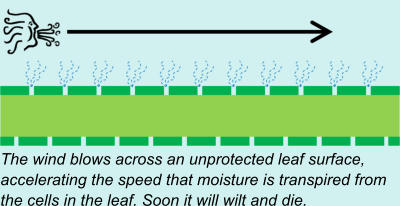
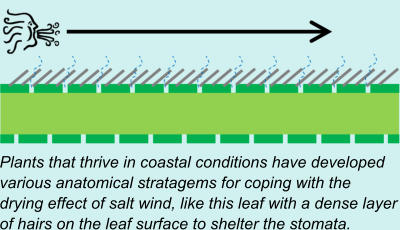
Plants that do well in coastal exposure have evolved strategies to reduce the damage done by wind and salt. Several of these
adaptations are external and morphological so we the gardeners can spot them, traits to look out for include:
•
Compact habit
Tight growth is often a sign of a plant from a windy environment, keeping your crown in a neat dome or low cushion
reduces the wind that can get in about your stems and leaves, reducing your exposed surface area. See also ‘Tall poppy
syndrome’.
•
Silver, grey or downy foliage
Coastal, alpine, Mediterranean and desert plants often have leaves coloured in reflective scales, these give a silvery look
to the plant. They benefit the plant by reducing airflow over the exposed pores and reducing the amount of solar
radiation that reaches the leaf surface, so cooling it and slowing water loss through transpiration.
•
Narrow or small foliage
A sheet of paper has a very high surface area to volume ratio, wad it up into a ball and the exposed surface area to
volume is much reduced. Plants loose moisture through the exposed surface of their tissues so many plants evolved to
suit exposed habitats have reduced the surface area of their leaves, rolling them up or shrinking them down, reducing
them to needles or even abandoning leaves altogether and existing by photosynthesising stems.
•
Thick coating
Some plants have armour plated their pores by adding a thick waxy cuticle to their lamina (leaf surface), this denser
layer protects the pores from the salt and reduces the amount of water lost to the wind.

Battered And Bruised
While the airflow and salt suck the moisture from the plant’s tissues the buffeting of the plant physical damages the plant tissues.
Unlike animals plants cells are enclosed by cell walls and when they are ruptured the cell dies. The waggling or fluttering back and
forth in the wind can break the cell walls.
Strong wind can of course break branches, rip them from their sockets and uproot whole trees, but a particular problem for coastal
gardens is wind rock. Wind rock is when prolonged wind has shaken the plant loose from the roots, it has lost the finer roots that
held it fast and now it is free to waggle all over the place. Brooms are especially prone to wind rock and should be clipped post
flowering to keep them more compact and less like a flapping sail.
Guess which way the wind blows? Leptospermum scoparium on Stewart Island, NZ. Salt wind kills
off and wears down windward shoots giving the whole plant a windblown, sculpted form.
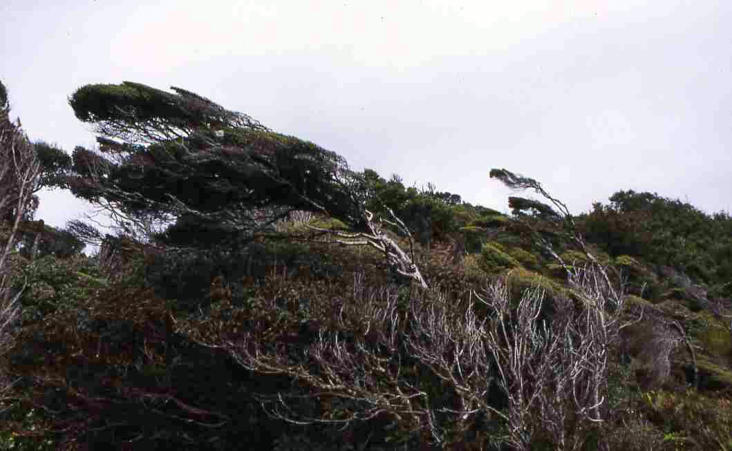

Rhododendron yakushimanum 'Koichiro Wada' makes a great case study for the above traits, exhibiting some degree of all of them
and it comes as no surprise that it is one of very few Rhododendron that tolerate coastal exposure.
Problems And Solutions











© Garden Cottage Nursery, 2021


Problems And Solutions
Coastal Gardening
The defining difficulty for a plant living in a coastal situation is
increased exposure to winds, specifically wind containing salt
spray. The problems come from physical and chemical assaults.
Photosynthesis
As we all know from biology at school plants all require light,
carbon dioxide and water to grow. These three are the basic
components used in the chloroplasts that are the factories of
plant growth, leaves could be thought of as the industrial estates
where the plant town planners concentrate these factories. So
over millions of years of evolution the basic design of a leaf is a
flattened structure only a few cells thick so light can penetrate to
provide the chloroplasts with energy. Now like all good factories
you need a chimney, but here the stomata (pores) let waste
oxygen out (handily for us animals) and CO
2
in. The requisite
water is pumped up from the ground through the root system
and the vascular tissues in the stems. The pump for this to draw
water up against the pull of gravity works largely through
transpiration, water evaporates slowly through the stomata
which draws more water up behind it as long as there is a
continuous stream of water from leaf to root.
Blow Dried
Leaves work by being slightly permeable to water, the problem
comes for a plant then when your leaf is placed in a stronger
airflow, like using a hair drier to speed drying your hair, the
heating element encourages evaporation, but the wind of the fan
does much of the work of carrying off the moisture.

Red Wine Stains
We all know the old wives ‘pour salt on it’ cure for red wine spills
on carpets, well the idea is that water is drawn especially
vigorously towards salt. Adding some dissolved salt to your
already drying wind really speeds up the drying effect on plant
tissues.
Rime
After a salty gale windward windows will often have a salty rime
to them. The same happens to plants, suspended droplets of
salt-infused water were carried by the wind and deposited on
the plant, the water evaporates leaving behind the salt, which
then burns the plant by sucking the moisture from it. It is a good
idea to go out with hose and rinse your plants the morning after
a gale if there was little rain accompanying the wind.

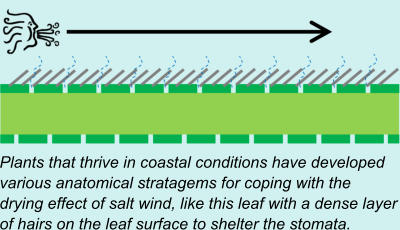
Plants that do well in coastal exposure have evolved strategies
to reduce the damage done by wind and salt. Several of these
adaptations are external and morphological so we the gardeners
can spot them, traits to look out for include:
•
Compact habit
Tight growth is often a sign of a plant from a windy
environment, keeping your crown in a neat dome or
low cushion reduces the wind that can get in about
your stems and leaves, reducing your exposed
surface area. See also ‘Tall poppy syndrome’.
•
Silver, grey or downy foliage
Coastal, alpine, Mediterranean and desert plants
often have leaves coloured in reflective scales, these
give a silvery look to the plant. They benefit the plant
by reducing airflow over the exposed pores and
reducing the amount of solar radiation that reaches
the leaf surface, so cooling it and slowing water loss
through transpiration.
•
Narrow or small foliage
A sheet of paper has a very high surface area to
volume ratio, wad it up into a ball and the exposed
surface area to volume is much reduced. Plants loose
moisture through the exposed surface of their tissues
so many plants evolved to suit exposed habitats have
reduced the surface area of their leaves, rolling them
up or shrinking them down, reducing them to needles
or even abandoning leaves altogether and existing by
photosynthesising stems.
•
Thick coating
Some plants have armour plated their pores by
adding a thick waxy cuticle to their lamina (leaf
surface), this denser layer protects the pores from the
salt and reduces the amount of water lost to the wind.

Battered And Bruised
While the airflow and salt suck the moisture from the plant’s
tissues the buffeting of the plant physical damages the plant
tissues.
Unlike animals plants cells are enclosed by cell walls and when
they are ruptured the cell dies. The waggling or fluttering back
and forth in the wind can break the cell walls.
Strong wind can of course break branches, rip them from their
sockets and uproot whole trees, but a particular problem for
coastal gardens is wind rock. Wind rock is when prolonged wind
has shaken the plant loose from the roots, it has lost the finer
roots that held it fast and now it is free to waggle all over the
place. Brooms are especially prone to wind rock and should be
clipped post flowering to keep them more compact and less like
a flapping sail.
Guess which way the wind blows? Leptospermum scoparium on
Stewart Island, NZ. Salt wind kills off and wears down windward
shoots giving the whole plant a windblown, sculpted form.
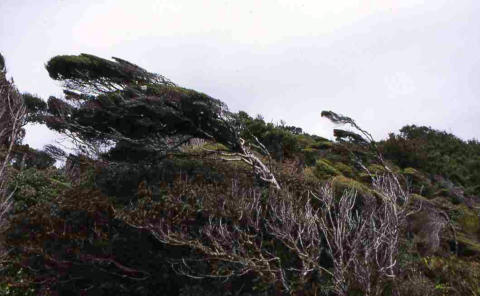

Rhododendron yakushimanum 'Koichiro Wada' makes a great
case study for the above traits, exhibiting some degree of all of
them and it comes as no surprise that it is one of very few
Rhododendron that tolerate coastal exposure.

























